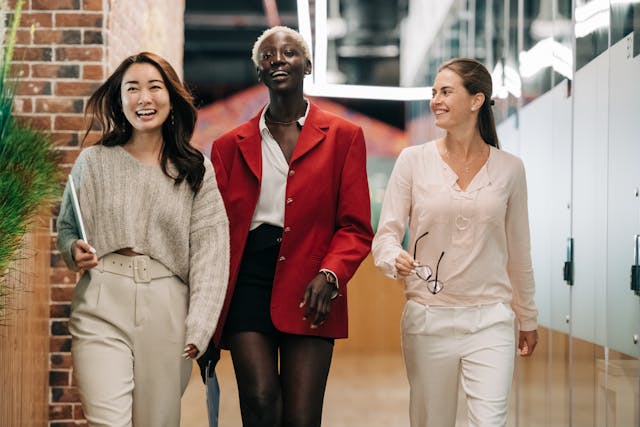
Trends are a ubiquitous part of our daily lives, influencing everything from fashion and music to technology and social media.
But why do people follow trends?
Is it a desire to fit in, a need for validation, or something more?
In this article, we’ll explore the psychological and practical reasons behind trend-following, and examine the benefits and drawbacks of this phenomenon.
The Psychological Pull of Trends
The allure of trends extends beyond just following the latest fashion or viral TikTok challenge.
It taps into deeper psychological drivers that shape human behavior and social dynamics:
Social connection
Humans are inherently social beings, craving connection and belonging.
Trends serve as a vehicle for fostering these connections by providing a common ground for individuals to come together.
When we participate in a trend, whether it’s adopting a popular hairstyle or trying out a new hobby, we feel a sense of camaraderie with others who share similar interests and values.
This sense of belonging to a larger community can be incredibly fulfilling and motivating, driving us to embrace trends as a way to strengthen social bonds.
Fear of Missing Out (FOMO)
In today’s hyper-connected world, FOMO has emerged as a powerful force driving trend-following behaviors.
The fear of being left out or missing out on experiences can be overwhelming, especially with the constant influx of updates and notifications on social media platforms.
Seeing others participate in a trend triggers a sense of urgency and anxiety, compelling us to join in to avoid feeling left behind.
Whether it’s attending a popular event or jumping on a viral hashtag, FOMO exerts a significant influence on our decision-making process, pushing us to embrace trends to stay relevant and connected.
Validation and self-esteem
Trends often serve as a barometer of social status and acceptance, influencing how we perceive ourselves and others.
When we see individuals embracing a particular trend, whether it’s wearing a certain brand of clothing or adopting a specific lifestyle, it signals to us what is considered desirable or aspirational within our social circles.
By aligning ourselves with these trends, we seek validation and acceptance from others, bolstering our self-esteem and sense of identity.
Feeling like we’re part of the “in” crowd or conforming to societal norms can provide a reassuring sense of belonging and validation, driving us to embrace trends as a means of affirming our social standing.

The Practical Benefits of Trends
The practical benefits of trends extend beyond just following the crowd; they offer tangible advantages that make our lives easier and more efficient:
Information and discovery
Trends serve as a gateway to new ideas, products, and services, enriching our lives with fresh experiences and insights.
By staying attuned to trends, whether it’s in entertainment, culture, or technology, we expose ourselves to a wealth of information and discoveries that we might not have encountered otherwise.
From discovering a groundbreaking TV series to stumbling upon innovative gadgets, following trends broadens our horizons and keeps us informed about the latest developments in our areas of interest.
Efficiency and decision-making
Embracing trends can streamline decision-making processes and simplify complex choices.
In realms like fashion and lifestyle, where options abound, following a trend offers a clear roadmap, sparing us the mental gymnastics of pondering what to wear or how to style our hair.
Instead of grappling with endless possibilities, adhering to a trend provides a convenient shortcut, allowing us to make decisions swiftly and confidently.
This efficiency not only saves time and effort but also alleviates decision fatigue, freeing up mental bandwidth for more important tasks.
Convenience and comfort
Trends offer a sense of predictability and familiarity, providing a comforting anchor in an ever-changing world.
When we follow a trend, we know what to expect, which can be reassuring in areas like technology, where rapid advancements can be overwhelming.
By aligning ourselves with trends in technology, for instance, we ensure that we’re leveraging the latest tools and platforms, enhancing our efficiency and productivity.
Similarly, in lifestyle choices, following trends can bring a sense of ease and convenience, as we navigate through familiar territories and routines with confidence.

How Do Trends Affect Our Self-Esteem and Validation
Trends can have both positive and negative impacts on our self-esteem and validation.
Positive Impacts
Social acceptance
Following trends can create a sense of belonging and acceptance within a group.
When we dress or behave in a way that is similar to others, it can signal that we are part of the group and that we share the same values.
This can boost our self-esteem and make us feel more confident.
Feeling trendy
Aligning with trends can boost self-esteem by making you feel fashionable, knowledgeable, or “in the know.”
Trends are often associated with positive attributes, such as being stylish, cool, or successful.
When we follow trends, we can internalize these positive associations and feel better about ourselves.
Validation
Receiving compliments or positive attention for following a trend can be validating.
Social approval is a basic human need, and when we receive it for our appearance or behavior, it can confirm that we are on the right track.
This can be especially important for teenagers and young adults, who are still developing their sense of self.
Negative Impacts
Pressure to conform
Trends can create pressure to conform, leading to feelings of inauthenticity if they clash with your personal style.
When we feel like we have to follow trends in order to fit in, it can lead us to deny our own preferences and individuality.
This can be inauthentic and make us feel like we are not being true to ourselves.
Keeping up with the joneses
The constant pressure to keep up with the latest trends can be financially draining and lead to feelings of inadequacy.
Trends are constantly changing, and it can be expensive to keep up with all of them.
This can lead to feelings of inadequacy and insecurity, especially if we compare ourselves to others who seem to have more money or possessions.
Focus on external validation
Relying solely on trends for validation can create a fragile self-esteem that fluctuates with the ever-changing trendscape.
If our sense of worth is based on whether or not we are following the latest trends, our self-esteem will be constantly at risk.
Trends are constantly changing, so what is popular today may be out of fashion tomorrow.
If we base our self-worth on trends, we will be setting ourselves up for disappointment and insecurity.

Examples of Trends That People Follow
Trends come in all shapes and sizes, affecting everything from what we wear to how we spend our free time.
Here’s a glimpse into the vast world of trends people follow:
Fashion
- Clothing styles: The ever-evolving world of fashion sees trends in silhouettes (think skinny jeans vs wide-leg pants), colors (neon green one season, earthy tones another), and embellishments (ruffles are in, then out, then back again!).
- Footwear: Sneaker trends are huge, with limited-edition releases causing frenzies. Classic styles like loafers or chunky boots can also become trendy.
- Accessories: Statement jewelry, hats, and bags can all be influenced by trends.
Food and beverage
- Dietary trends: Veganism, gluten-free options, and keto diets can all become trendy, influencing restaurant menus and grocery store offerings.
- Drinks: Cold brew coffee, bubble tea, or a specific type of cocktail can rise in popularity due to social media or celebrity influence.
- Food trends: Rainbow bagels, Dalgona coffee (whipped coffee popular during lockdowns), or trendy new açai bowls are all examples of consumable trends.
Technology and Entertainment
- Social media challenges: From the cinnamon challenge to the recent “Buss It Down” dance trend, social media ignites challenges that go viral.
- Streaming services: Different streaming platforms might have trending shows or movies that everyone is talking about.
- Mobile apps: New and innovative apps, like a language learning platform or a meditation app, can gain massive popularity quickly.
Lifestyle
- Fitness trends: High-intensity interval training (HIIT), yoga variations, or home gym setups can all become trendy workout options.
- Travel destinations: Certain cities or regions experience a surge in tourism due to social media hype or celebrity visits.
- Hobbies and activities: Adult coloring books, sourdough baking during lockdowns, or learning a new language can all be trending hobbies.
Finding Your Balance with Trends

While following trends can have many benefits, it’s also important to find a balance.
Trends can be fleeting, and following them too closely can lead to a sense of superficiality or lack of authenticity.
It’s important to find a balance between following trends and staying true to oneself.
Embrace the good
Discovery
Trends can introduce you to new things you might genuinely love.
A food trend could lead you to a delicious new restaurant, or a fitness trend could spark a lifelong passion for a certain exercise.
Social connection
Trends create a sense of shared experience.
Talking about the latest show or sporting a trendy outfit can be a conversation starter and a way to bond with others.
Efficiency
Trends can simplify decision-making.
If everyone’s raving about a new app, it might be worth checking out. This can save you time and effort when exploring new options.
Be mindful
Authenticity
Don’t blindly follow trends that clash with your personality or style.
It’s okay to wear skinny jeans even if wide-leg pants are “in.” Authenticity is more attractive than forced conformity.
Budget
Trends can be expensive!
Think twice before splurging on a trendy item you might not wear for long. Focus on quality pieces you’ll love for years to come.
FOMO (Fear of Missing Out)
Social media can make trends seem like the only thing happening.
Don’t get caught up in FOMO. If a trend doesn’t resonate with you, skip it!
Pursue activities and interests that truly spark joy.
Strike a Balance
Curate, don’t consume
Pick and choose elements of trends that you genuinely like.
You can rock a trendy top with your favorite pair of jeans, or try a new recipe with a healthy twist.
Focus on quality
Invest in timeless pieces you’ll wear for years.
Trendier items can be fun accents, but a solid foundation of classic clothes will serve you well.
Embrace your uniqueness
Trends come and go, but your personal style is here to stay.
Don’t be afraid to experiment and express yourself through your clothing, hobbies, and interests.
Conclusion
In conclusion, people follow trends for a variety of psychological and practical reasons.
From social connection and FOMO to validation and self-esteem, there are many drivers behind trend-following.
While following trends can have many benefits, it’s also important to find a balance and stay true to oneself.
By understanding the psychological and practical benefits of trends, we can make more informed decisions about how we engage with them.


